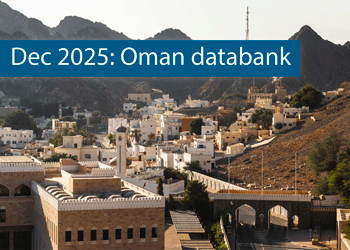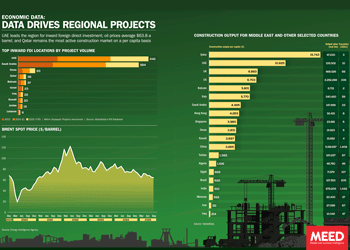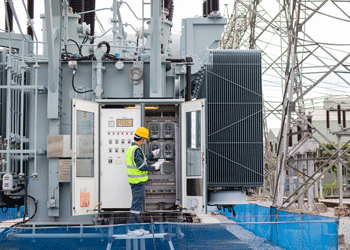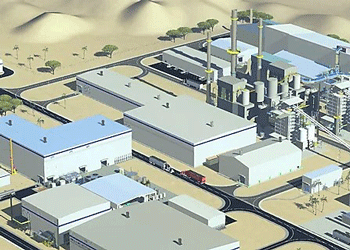Oman’s mining ambitions take a leap forward
10 December 2024

While Oman is at a disadvantage in terms of hydrocarbon reserves compared to its Gulf neighbours, when it comes to mineral resources, the sultanate, with its considerably large geographical area, enjoys benefits that its Gulf peers – barring Saudi Arabia – do not.
Exploration for mineral resources and mining activities for metals production are fundamental pillars of Oman Vision 2040 – a socio-economic strategy designed to diversify the sultanate’s economy away from oil and gas revenues and harness the potential of non-hydrocarbon industrial sectors.
At the forefront of this ambition is Minerals Development Oman (MDO), which was created in 2017 to explore the country’s mineral resources base and develop the mining sector.
Minerals exploration and production
MDO, a subsidiary of Oman Investment Authority, continues to advance its exploration campaigns across a range of minerals, including copper, chromite, gypsum, limestone, dolomite and silica.
The company had a major success recently when its subsidiary, Mazoon Mining, broke ground on a copper concentrate production project in Yanqul in northwestern Oman.
The Mazoon copper project site, located in the wilayat of Yanqul in Al-Dhahirah Governorate, covers 20 square kilometres (sq km) and comprises five open-pit mines. It is estimated to hold copper ore reserves of 22.9 million tonnes.
The project includes the construction of a processing plant spanning 56,000 square metres, with the capacity to process 2.5 million tonnes a year (t/y) of copper ore.
The Mazoon copper project will have the capacity to produce 115,000 t/y of copper concentrate, at a 21.5% copper grade, making it the largest copper concentrate production project in the sultanate.
Mazoon Mining was granted exclusive rights by Oman’s Energy & Minerals Ministry in 2022 to explore, develop and produce copper concentrates in concession area 12-A1, with gold as a secondary by-product.
Following feasibility studies, Australian/Canadian firm Lycopodium was appointed as the engineering, procurement and construction management contractor for the Yanqul project.
Construction of the processing plant is planned to begin in the first quarter of 2025, and production of copper concentrate is set to commence in the first quarter of 2027.
In addition to the Mazoon copper project, MDO has also initiated the redevelopment of copper mines in Sohar and Liwa, aiming to produce 800,000 t/y of copper ore annually, with confirmed reserves of 2.78 million t/y of copper ore.
In October, the Omani Ministry of Energy & Minerals awarded MDO a concession agreement to explore and develop silica resources in Block 51F in the wilayat of Mahout in Al-Wusta Governorate. The block covers 2,156 sq km and is estimated to hold silica, limestone and dolomite deposits.
Steel production investments
Several other metal production projects in Oman, particularly steel schemes, have also made progress in recent months.
In late October, Brazilian mining major Vale and China’s Jinnan Iron & Steel Group entered a joint venture (JV) to establish an iron ore concentration plant in Oman’s northern city of Sohar.
The Brazilian-Chinese JV intends to invest more than $600m in the iron ore concentration plant project, which will be the first such facility in Oman.
Vale will invest $227m to connect the plant to its agglomerate facilities in the region, while Jinnan will invest about $400m to build, own and operate the plant.
The planned complex, to be located within Sohar Port and Freezone, is scheduled to start operations by mid-2027.
The plant will be able to process 18 million t/y of iron ore and produce 12.6 million t/y of high-grade concentrate.
The proposed iron ore concentration plant project in Sohar is understood to be the second-biggest foreign investment in Oman’s steel industry. As such, it will contribute to the sultanate becoming a key player in the global supply chain for direct reduction grade iron ore (DRI).
Vulcan Green Steel (VGS), the steel arm of Vulcan Green, which is owned by India’s Jindal Steel Group, is developing the largest green steel project in Oman. VGS broke ground on the estimated $3bn project in December 2023.
The planned facility, which covers 2 sq km in the Special Economic Zone at Duqm (Sezad), will have two 2.5 million t/y production lines, comprising DRI units, an electric arc furnace and a hot strip mill.
The planned facility, set for completion by 2026, will primarily use green hydrogen to produce 5 million t/y of green steel. Once commissioned, it will be the world’s largest renewable energy-based green steel manufacturing complex.
Sezad could also host another large-scale green steel project if Japanese steel manufacturer Kobe Steel and Tokyo-based Mitsui & Company can reach the final investment decision on a preliminary agreement they signed in April 2023 to develop a low-carbon iron metallics project.
The two Japanese firms agreed to conduct a detailed business study in line with the goal of commencing low-carbon dioxide iron metallics production by 2027. The project is expected to produce 5 million t/y of DRI using a process called Midrex, where DRI is produced from iron ores through a natural gas or hydrogen-based shaft furnace.
Polysilicon production
Oman is also set to become a key regional producer of polysilicon once private player United Solar Polysilicon completes the construction of its estimated $1.35bn production facility in Sohar Port and Freezone in 2025.
The polysilicon plant will have the capacity to produce 100,000 t/y of high-quality metallurgical silicon. United Solar Polysilicon broke ground on the factory, which will be spread across 160,000 square metres, in March this year.
United Solar Polysilicon made further progress with the project in July when it awarded a contract to provide water services to Sohar-based Majis Industrial Services, a subsidiary of Omani state energy conglomerate OQ Group.
Polysilicon is a high-purity form of silicon, which is a key raw material in producing solar photovoltaic panels. Polysilicon production involves pouring the liquid metallurgical silicon from the furnace into moulds and then cooling it through mould or continuous casting. After cooling, the metallurgical silicon is ground and packaged for global export.
Exclusive from Meed
-
 Navigating financial markets amid geopolitical fragmentation
Navigating financial markets amid geopolitical fragmentation28 December 2025
-
 Oman’s growth forecast points upwards
Oman’s growth forecast points upwards24 December 2025
-
 December 2025: Data drives regional projects
December 2025: Data drives regional projects23 December 2025
-
 Local firm bids lowest for Kuwait substation deal
Local firm bids lowest for Kuwait substation deal22 December 2025
-
 Saudi-Dutch JV awards ‘supercentre’ metals reclamation project
Saudi-Dutch JV awards ‘supercentre’ metals reclamation project22 December 2025
All of this is only 1% of what MEED.com has to offer
Subscribe now and unlock all the 153,671 articles on MEED.com
- All the latest news, data, and market intelligence across MENA at your fingerprints
- First-hand updates and inside information on projects, clients and competitors that matter to you
- 20 years' archive of information, data, and news for you to access at your convenience
- Strategize to succeed and minimise risks with timely analysis of current and future market trends

Related Articles
-
 Navigating financial markets amid geopolitical fragmentation
Navigating financial markets amid geopolitical fragmentation28 December 2025

As we move towards 2026, geopolitical fragmentation is no longer a background risk that occasionally disrupts markets.
It has become a defining feature of the global financial landscape. Shifting alliances, persistent regional tensions, sanctions and the reconfiguration of supply chains are reshaping how capital flows, how liquidity behaves and how confidence is formed.
For firms operating in the Middle East, this does not simply mean preparing for more volatility. It means operating in a system where the underlying rules are evolving.
For much of the past three decades, businesses and investors worked within a broadly convergent global framework. Trade expanded, financial markets deepened and policy coordination – while imperfect – created a sense of predictability. That environment has changed.
Today, economic decisions are increasingly influenced by strategic alignment, security considerations and political resilience. Markets still function, but they do so in a more fragmented and less forgiving way.
Shifting landscape
One of the most important consequences of this shift is that risk no longer travels along familiar paths. In the past, geopolitical events were often treated as temporary shocks layered onto an otherwise stable system.
Today, they shape the system itself. Trade flows are influenced as much by political compatibility as by cost efficiency. Supply chains, once optimised for speed and scale, are reorganising into regional or allied clusters. Financial markets respond not only to data, but to narratives about stability, alignment and long-term credibility.
This change places greater pressure on firms that rely on historical relationships to guide decisions. Models built on past correlations – between interest rates and equity markets, or between energy prices and regional growth – are less reliable when markets move between different regimes. The challenge is not simply higher volatility, but the fact that correlations themselves can shift quickly.
Monetary policy adds a second layer of complexity. Major central banks are no longer moving in step. The US, Europe and parts of Asia face different inflation dynamics and political constraints, leading to diverging interest-rate paths.
For the GCC, where currencies are largely pegged to the US dollar, this divergence has direct consequences. Local financial conditions are closely tied to decisions taken by the Federal Reserve, even when regional economic conditions follow a different cycle.
This matters because funding costs, liquidity availability and hedging conditions are shaped by global rather than local forces. When US policy remains tight, dollar liquidity becomes more selective. When expectations shift abruptly, market depth can disappear quickly.
For firms with international exposure, long-term investment plans, or reliance on external financing, these dynamics require careful management. They cannot be treated as secondary macro considerations.
Energy markets further complicate the picture. The Middle East remains central to global energy supply, which means geopolitical events often interact with oil prices and financial conditions at the same time.
When shifts in energy expectations coincide with changes in global interest-rate sentiment, liquidity conditions can tighten rapidly. This interaction is well known in academic research on fixed exchange-rate systems, but its practical implications are often underestimated in corporate planning.
Expanding vulnerabilities
These dynamics expose clear vulnerabilities. Concentrated supply chains are more susceptible to disruption. Financing structures dependent on continuous market access are more exposed to sudden repricing. Risk management approaches that assume stable relationships between assets are more likely to disappoint. Operational risks – particularly in technology and data – are increasingly shaped by geopolitical considerations rather than purely technical ones.
At the same time, the region enters 2026 from a position of relative strength. GCC economies benefit from fiscal buffers, long-term investment programmes and a growing perception of stability compared to other parts of the world. In an environment where uncertainty is widespread, predictability itself becomes valuable. Capital increasingly seeks jurisdictions that combine economic ambition with institutional credibility.
The question, therefore, is not whether opportunities exist, but whether firms are prepared to capture them responsibly. This requires a shift in how future risks are assessed and embedded into decision-making. Linear forecasts and static plans are insufficient when the environment itself can change state. Scenario thinking must evolve beyond optimistic and pessimistic cases to reflect different combinations of geopolitical alignment, monetary conditions, and supply-chain stability. These scenarios should inform capital allocation, not sit in strategy documents.
Liquidity and risk management discipline also become central. In both trading and corporate finance, experience shows that many failures stem not from being wrong on direction, but from being overexposed when conditions change. Scaling risk to market conditions, maintaining funding flexibility and understanding how quickly liquidity can evaporate are essential practices. This is as true for corporate balance sheets as it is for trading books.
Operational resilience must be viewed through the same lens. Supply-chain redundancy, cybersecurity preparedness and data governance are no longer purely operational concerns. They influence financial stability, investor confidence and regulatory trust. In a fragmented world, operational disruptions can quickly translate into financial and reputational damage.
Facing the future
As we approach 2026, leadership in the Middle East faces a clear test. The global environment is unlikely to become simpler or more predictable. Firms that continue to rely on assumptions shaped by a different era will find themselves reacting rather than positioning. Those that invest in disciplined risk management, flexible planning and operational resilience will be better placed to navigate uncertainty and to turn volatility into strategic advantage.
In this environment, risk management is not an obstacle to growth. It is the framework that makes sustainable growth possible.
Ultimately – and this is an often overlooked critical point – none of these adjustments, whether in scenario planning, liquidity discipline, or operational resilience, can be effective without the right human capital in place.
Geopolitical fragmentation and financial volatility are not risks that can be fully addressed through models or policies alone. They require informed judgement, institutional memory and the ability to interpret weak signals before they become material threats or missed opportunities.
Firms that succeed in this environment will be those that deliberately invest in corporate knowledge: building internal capabilities where possible and complementing them with external expertise where necessary. This means involving professionals with the right background, cross-market experience and a proven, proactive approach to risk awareness and governance.
In a fragmented world, competitive advantage increasingly depends not only on capital or strategy, but on the quality of people entrusted with understanding risk, challenging assumptions and guiding decision-making under uncertainty.
 https://image.digitalinsightresearch.in/uploads/NewsArticle/15306336/main.gif
https://image.digitalinsightresearch.in/uploads/NewsArticle/15306336/main.gif -
 Oman’s growth forecast points upwards
Oman’s growth forecast points upwards24 December 2025

MEED’s January 2026 report on Oman includes:
> COMMENT: Oman steadies growth with strategic restraint
> GVT & ECONOMY: Oman pursues diversification amid regional concerns
> BANKING: Oman banks feel impact of stronger economy
> OIL & GAS: LNG goals galvanise Oman’s oil and gas sector
> POWER & WATER: Oman prepares for a wave of IPP awards
> CONSTRUCTION: Momentum builds in construction sectorTo see previous issues of MEED Business Review, please click herehttps://image.digitalinsightresearch.in/uploads/NewsArticle/15306449/main.gif -
 December 2025: Data drives regional projects
December 2025: Data drives regional projects23 December 2025
Click here to download the PDF
Includes: Top inward FDI locations by project volume | Brent spot price | Construction output
MEED’s January 2026 report on Oman includes:
> COMMENT: Oman steadies growth with strategic restraint
> ECONOMY: Oman pursues diversification amid regional concerns
> BANKING: Oman banks feel impact of stronger economy
> OIL & GAS: LNG goals galvanise Oman’s oil and gas sector
> POWER & WATER: Oman prepares for a wave of IPP awards
> CONSTRUCTION: Momentum builds in construction sectorTo see previous issues of MEED Business Review, please click herehttps://image.digitalinsightresearch.in/uploads/NewsArticle/15306140/main.gif -
 Local firm bids lowest for Kuwait substation deal
Local firm bids lowest for Kuwait substation deal22 December 2025
The local Al-Ahleia Switchgear Company has submitted the lowest price of KD33.9m ($110.3m) for a contract to build a 400/132/11 kV substation at the South Surra township for Kuwait’s Public Authority for Housing Welfare (PAHW).
The bid was marginally lower than the two other offers of KD35.1m and KD35.5m submitted respectively by Saudi Arabia’s National Contracting Company (NCC) and India’s Larsen & Toubro.
PAHW is expected to take about three months to evaluate the prices before selecting the successful contractor.
The project is one of several transmission and distribution projects either out to bid or recently awarded by Kuwait’s main affordable housing client.
This year alone, it has awarded two contracts worth more than $100m for cable works at its 1Z, 2Z, 3Z and 4Z 400kV substations at Al-Istiqlal City, and two deals totalling just under $280m for the construction of seven 132/11kV substations in the same township.
Most recently, it has tendered two contracts to build seven 132/11kV main substations at its affordable housing project, west of Kuwait City. The bid deadline for the two deals covering the MS-01 through to MS-08 substations is 8 January.
https://image.digitalinsightresearch.in/uploads/NewsArticle/15305745/main.gif -
 Saudi-Dutch JV awards ‘supercentre’ metals reclamation project
Saudi-Dutch JV awards ‘supercentre’ metals reclamation project22 December 2025
The local Advanced Circular Materials Company (ACMC), a joint venture of the Netherlands-based Shell & AMG Recycling BV (SARBV) and local firm United Company for Industry (UCI), has awarded the engineering, procurement and construction (EPC) contract for the first phase of its $500m-plus metals reclamation complex in Jubail.
The contract, estimated to be worth in excess of $200m, was won by China TianChen Engineering Corporation (TCC), a subsidiary of China National Chemical Engineering Company (CNCEC), following the issue of the tender in July 2024.
Under the terms of the deal, TCC will process gasification ash generated at Saudi Aramco’s Jizan refining complex on the Red Sea coast to produce battery-grade vanadium oxide and vanadium electrolyte for vanadium redox flow batteries. AMG will provide the licensed technology required for the production process.
The works are the first of four planned phases at the catalyst and gasification ash recycling ‘Supercentre’, which is located at the PlasChem Park in Jubail Industrial City 2 alongside the Sadara integrated refining and petrochemical complex.
Phase 2 will expand the facility to process spent catalysts from heavy oil upgrading facilities to produce ferrovanadium for the steel industry and/or additional battery-grade vanadium oxide.
Phase 3 involves installing a manufacturing facility for residue-upgrading catalysts.
In the fourth phase, a vanadium electrolyte production plant will be developed.
The developers expect a total reduction of 3.6 million metric tonnes of carbon dioxide emissions a year when the four phases of the project are commissioned.
SARBV first announced its intention to build a metal reclamation and catalyst manufacturing facility in Saudi Arabia in November 2019. The kingdom’s Ministry of Investment, then known as the Saudi Arabian General Investment Authority (Sagia), supported the project.
In July 2022, SARBV and UCI signed the agreement to formalise their joint venture and build the proposed facility.
The project has received support from Saudi Aramco’s Namaat industrial investment programme. Aramco, at the time, also signed an agreement with the joint venture to offtake vanadium-bearing gasification ash from its Jizan refining complex.
Photo credit: SARBV
https://image.digitalinsightresearch.in/uploads/NewsArticle/15305326/main.gif

